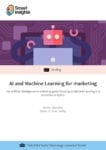AI, in a marketing context, is a form of optimization (designed to optimize marketing tasks, tools, and communications). It’s on the verge of transforming our roles and is spurring a revolution to our entire industry
Have you ever received a marketing communication from a brand that seemed as if it knew you almost too well — using your name, showing you enticing recommended items, or even reminder cart abandonment emails and unique codes and coupons? Sometimes they even turn up as though someone read your thought. Ever wondered how they do it, or how you can too?
The answer: Artificial intelligence marketing.
Indeed, Apple’s Siri product, Amazon’s Alexa and Google Home, or any of the dozens of other AI-driven digital assistants out there are already changing the role that machines play in making our lives easier. Marketers are using AI in similar ways.smart
Global B2C marketing organizations are using AI and its subset technologies — machine learning and deep learning — within their e-commerce strategies to unify the entire customer experience.
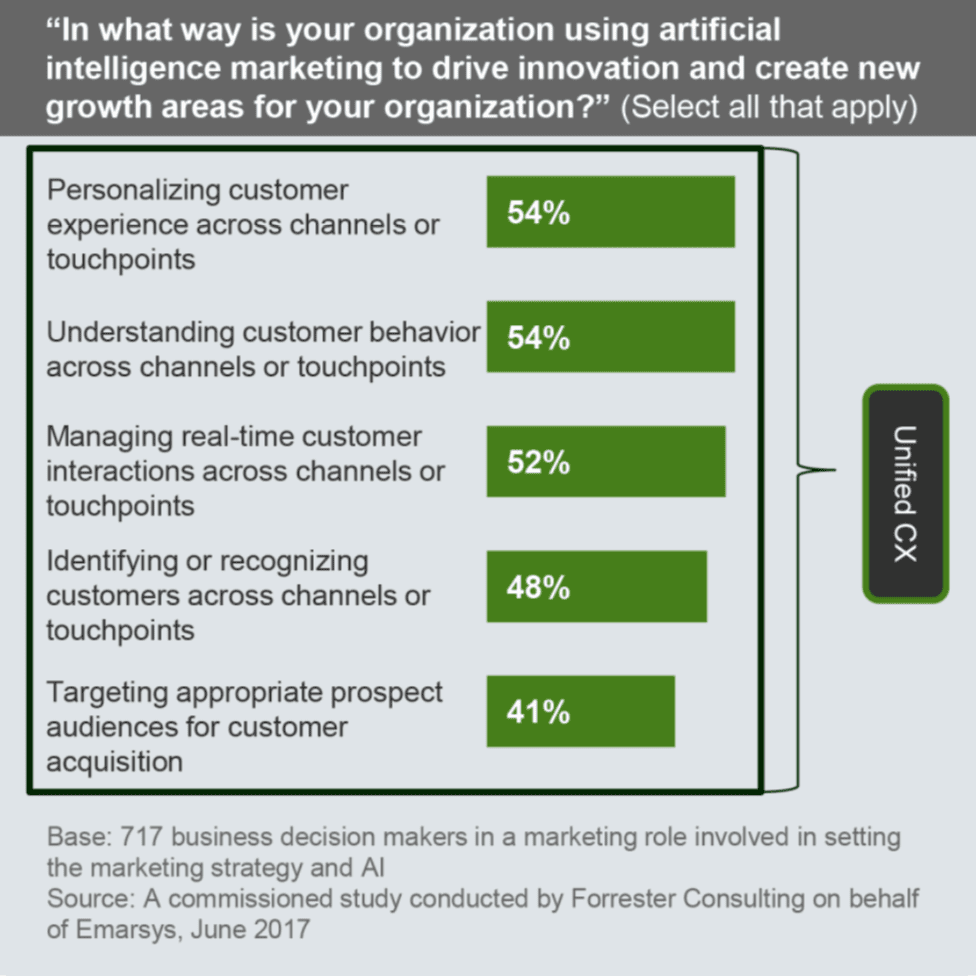
More than half of global marketers are using AI for personalization, to understand cross-channel customer behavior, and manage interactions. Source: Building Trust And Confidence: AI Marketing Readiness In Retail And eCommerce, Emarsys & Forrester, June 2017
Within the next couple years, mass adoption of AI marketing will ultimately cause a few things to happen:
- We’ll be able to move closer to actual personalized, 1-to-1 marketing
- The platforms and solutions we use to provide personalization will continue to improve
- Widespread AI adoption will spur a “war of algorithms,” resulting in more sophisticated targeting, more intelligent marketing teams, and more well-informed outputs
- Quality of content will become even more important
Throughout the rest of 2018 and into 2019, we’ll begin to see personalized marketing in action, and pinpoint areas of influence, success, and improvement when injecting AI into our automation platforms, and subsequently our strategies.
This brings up several interesting questions: what is true 1-to-1 marketing (what does it look and feel like), how does it actually work within a marketing platform (what’s actually happening beneath the hood), and how does AI play into all of this?
Download our Premium Resource – AI and Machine Learning for Marketing
Our Artificial Intelligence for Marketing Guide focusing on Machine Learning and Predictive Analytics. The guide aims to help businesses of all sizes to apply to their marketing, focusing on Artificial Intelligence. All businesses can now use the services we recommend to implement Machine Learning. The guide explains why, how with an actionable and practical approach.
Access the AI and Machine Learning for marketing briefing
What is 1-to-1 Marketing?
The beauty of AI is that it can, in theory (and in practice), define segments down to the individual — each person can get their own email, text message, app notification, web content, or other kind of communication.
If you have 3 million contacts, but you have 1 million segments, it’s not 1-to-1.
In its simplest form, true 1-to-1 marketing means each person gets their “own” message.
1-to-1 marketing is even more granular, more relevant, and ideally more engaging than “personalized marketing” as individualized, custom messages are made for each and every customer — though the terms are often used interchangeably. Essentially it’s answering these four basic questions of marketing who is my customer, what am I going to say to them, when am I going to interact with them and where am I going to interact with them.
How does 1-to-1 marketing manifest? Let’s look at a few examples.
1. Incentivizing Customer Interaction
Innovative brands are mixing content and creativity with personalization tactics for an unmatched “human” touch (“personal” is actually used twice in this email copy from sigma Beauty, and an individualized code is presented):
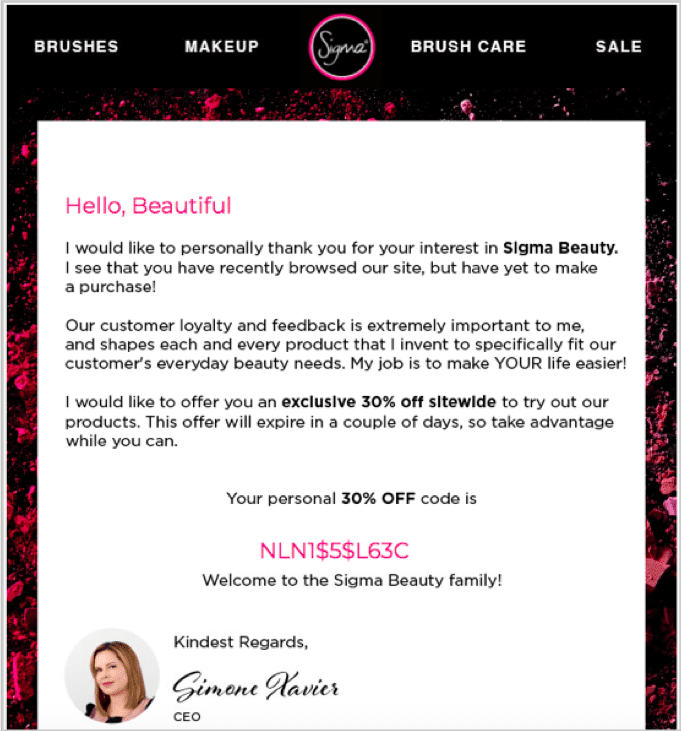
2. Event-based communications
Most B2C brands do special event-based communications, making them a “can’t-miss” (and can’t afford to get wrong) today:

3. Live updates and real-time content
“Open time content” is a technology that lets you provide real-time visibility into events like weather conditions, product availability, and use updated countdown clocks regardless when an email is opened:

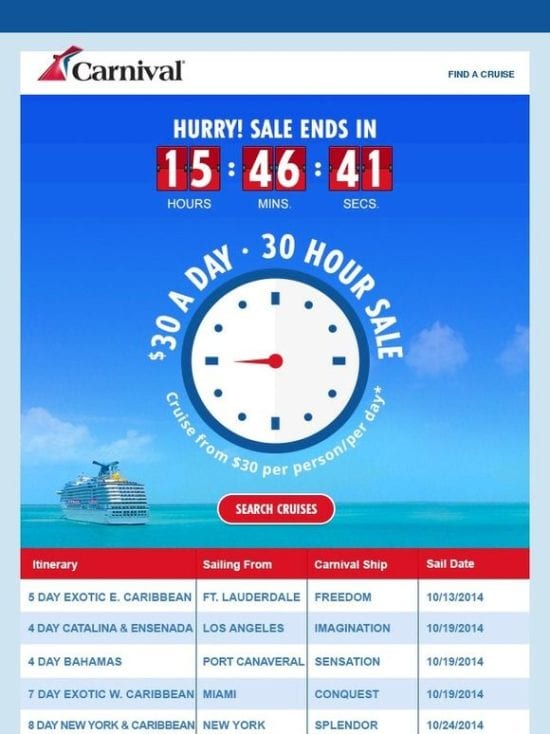
4. Browse and cart abandonment emails
You know the ones — you’re browsing an online store or begin to build a shopping cart, but exit your browser before completing a purchase… then, voilà, like magic, a couple hours later, you receive an email prompting you to resume your activity:
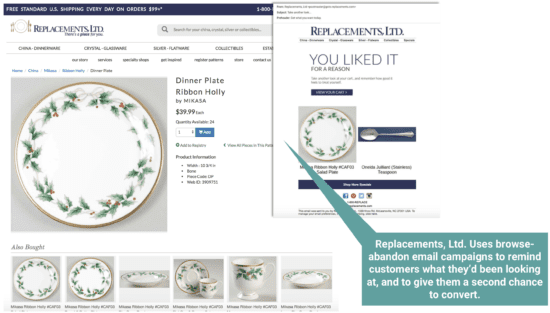
These examples are the tip of the iceberg in terms of the potential of AI marketing, but they showcase several real use cases of the manifestation of this disruptive technology.
The problem is that 1-to-1 marketing is impossible to achieve manually. Teams that attempt it may find some minimal and isolated success, but ultimately become crazed and overworked — feeling like marketers gone mad, or elves frantically and furiously breaking their backs to create, wrap, and organize every gift before the holidays.
When this process happens at scale across gigantic databases of hundreds of thousands of contacts, it requires specialized technology that can handle massive amounts of customer data.
With GDPR and e-privacy acts coming into play, third-party advertising will become much more restricted (if not completely non-existent in certain countries in Europe). This will put major pressure on retention marketing or first-party marketing — which means personalization/1-to-1 marketing will take centre stage.
Using Personalized Marketing Platforms
The majority of modern-day marketing clouds tend to enable some level of personalization, but only through a channel-by-channel lens.
This siloed approach limits the capability, creativity, and transparency of marketing teams, and, more importantly, can cause a disconnected customer experience. To overcome this common technological limitation, personalized communications are best when they’re calculated and executed based on singular customer events (explicit events like a customer making a purchase, or implicit events like customer churn and attrition).
Good personalization engines should be channel-agnostic, ensuring every interaction is personalized with the right content, independent of channel.
For example, a platform that consolidates all web, mobile, email and purchases information into a "unified customer profile" would include preferences, behavior trends, predicted behaviors, propensities, and affinities for individuals. This unified customer profile is the platform foundation, the "single source of truth," enabling hyper-personalization across all channels.
Personalization engines must understand the nature of these events, ascertain context of the event, create or choose relevant content (without any channel-specific styling), and ultimately syndicate that output via the correct channel based on customer preferences.
If this sounds far-fetched, complicated, or techy, rest assured that it’s the way of the present and future. But by leveraging AI, you VASTLY simplify this process — relying, in a sense, on the genius of the machine.
How Artificial Intelligence Marketing actually works
With AI marketing, you can automate the process of delivering personalized communications to your entire database, at scale, and across every channel. Let’s lift up the hood and see how it all happens.
Artificial intelligence works best when it’s “baked” into a marketing platform.
An underlying layer of code that’s hard-wired to “self-learn” can govern multiple channels, in multiple instances, and across a database. Thus, AI marketing works best when vertically integrated across a platform for enhanced capabilities, not when implemented within a single channel.
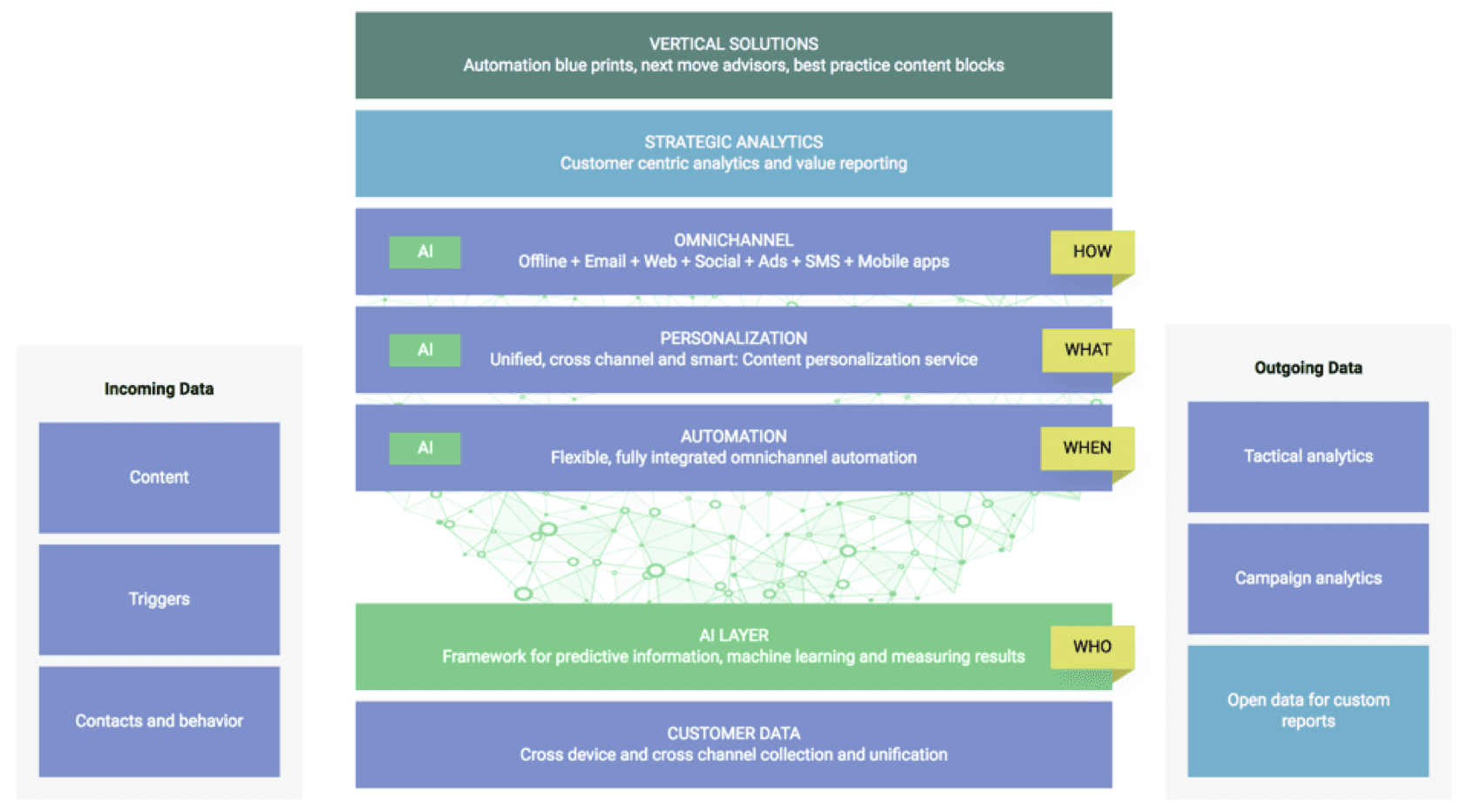
An embedded code lies underneath and informs every task that an AI-enabled marketing platform handles. While this illustration incorporates complex actions and confusing processes, it shows how AI is ingrained into an automation platform. Image source: Emarsys
Machines and algorithms that fuel intelligent systems must learn on their own, creating, reacting to, and defining rules that aren’t explicitly told to them by humans. On top of all that, these processes will all need to occur within a matter of milliseconds. A solution that helps you do this sits “on top of” all customer data with 360-degree coverage — including CRM, behavior, product, and external datasets
The good news? AI-driven solutions are built to make this easy to manage so you’re as hands-off as possible — in fact, they work best this way.
Marketers leveraging AI can literally tell a machine their strategy (e.g., setting a sliding scale to indicate how aggressively you want to discount an item for a particular campaign), and, because the machine has access to all customer data, it can do the rest.
AI systems/algorithms work in conjunction with previous behavior data to develop probabilities of certain events happening (like a customer purchasing), taking into account expected revenue/cost as well as the guidelines that you set in place to create a final output:
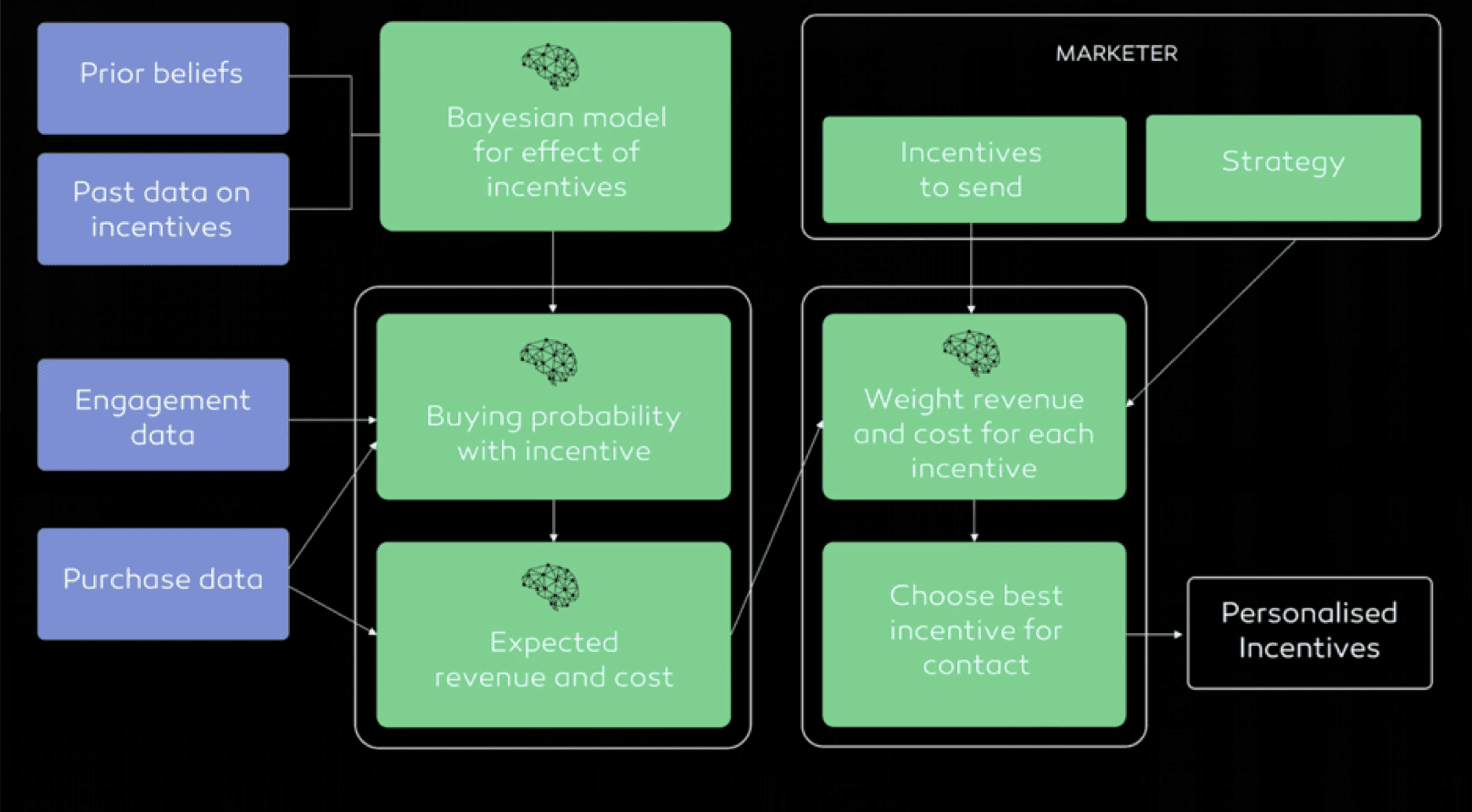
AI-enabled machines use algorithms, customer data, and other variables to help data-driven marketers send personalized content most likely to drive action, at the best time, to each contact.
With individual campaigns, through an extendable model, users can add many contact fields, relational data tables, or decision trees to create quite sophisticated models.
How incentives use AI
Let’s look at one use case, and how it works: incentives.
AI-enabled engines typically contain rules for personalizing. So, during “send-time,” the channels “call” the personalization engine, requesting content for individual contacts.
Since the machine is programmed to (a) consider all previous purchase, historical, and website data of each contact, (b) understand that information, (c) devise customized communications most likely to convert each contact, then (d) execute, it can intelligently, automatically evaluate how much to discount for every customer:
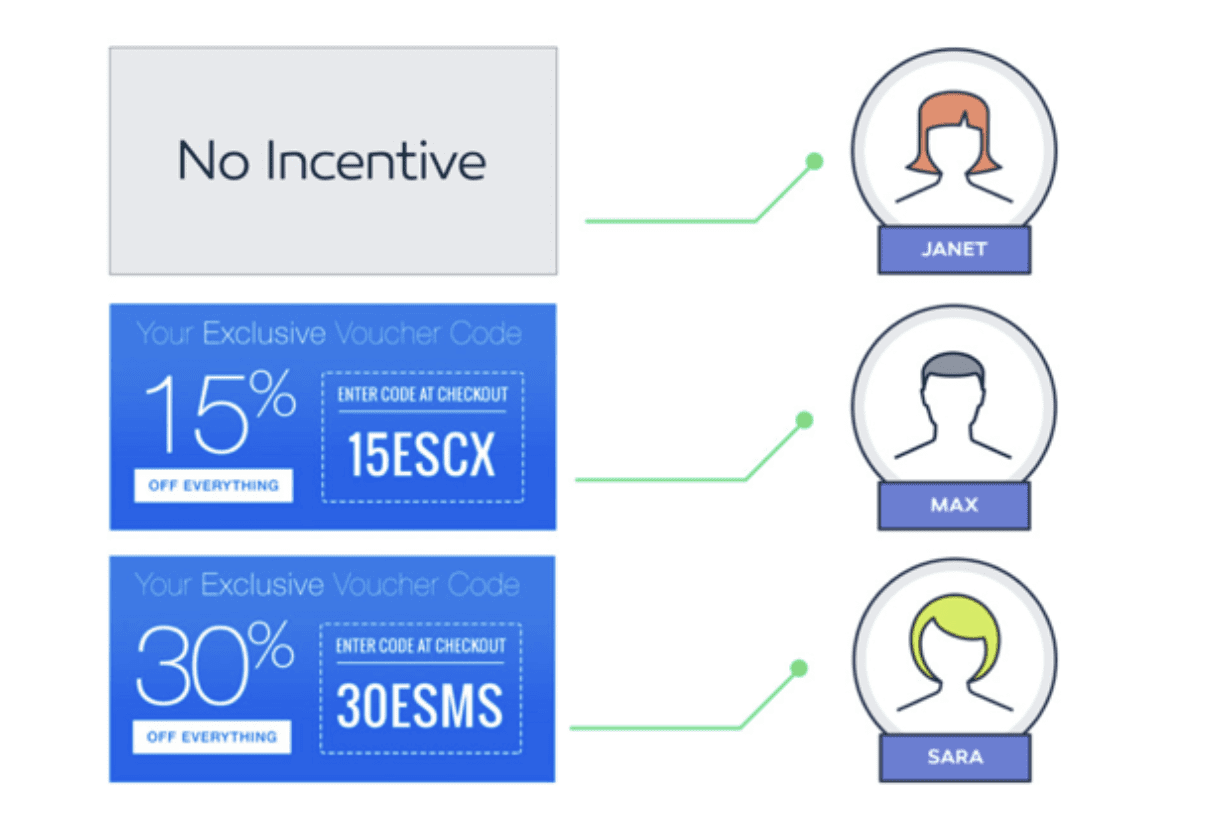
Incentivization is unique to every person — some people require steeper discounts, while some require no incentive. The machine knows how much to take off for every customer to maximize the likelihood of purchase.
Consumers are then provided with content most likely to engage them, personalized at the point of interaction.
Don’t fear, AI won’t take your job any time soon
Armed with quality marketing automation platforms (some leveraging AI or self-learning algorithms, some not), brands across the globe all face the same challenge of creating a superior customer experience — which will be the battlefield upon which victory will be had.
While machines can write some kinds of content, such as reports, they will never replace a human’s ability to tell stories with emotion, wit, humor, sincerity, and tact.
Even though advanced marketing applications allow for more real-time and automated interactions, the need for strategy, content, and creative work continues increases exponentially.
Menial and repeatable tasks (like segmenting data, crafting campaign blueprints, and creating if-then rules) should be and can be offloaded to the machine. Marketers will begin to concentrate solely on creating content, setting strategy, and guiding machines based on those strategies.
When all of this comes together, the end result is true omnichannel personalization that is driven by AI. AI marketing is the bridge that marketers must take to achieve personalization at scale.
Final Thoughts
AI is both tangible but also full of hype. AI, deep learning, and machine learning are at or nearing the peak of inflation in their respective hype cycles:
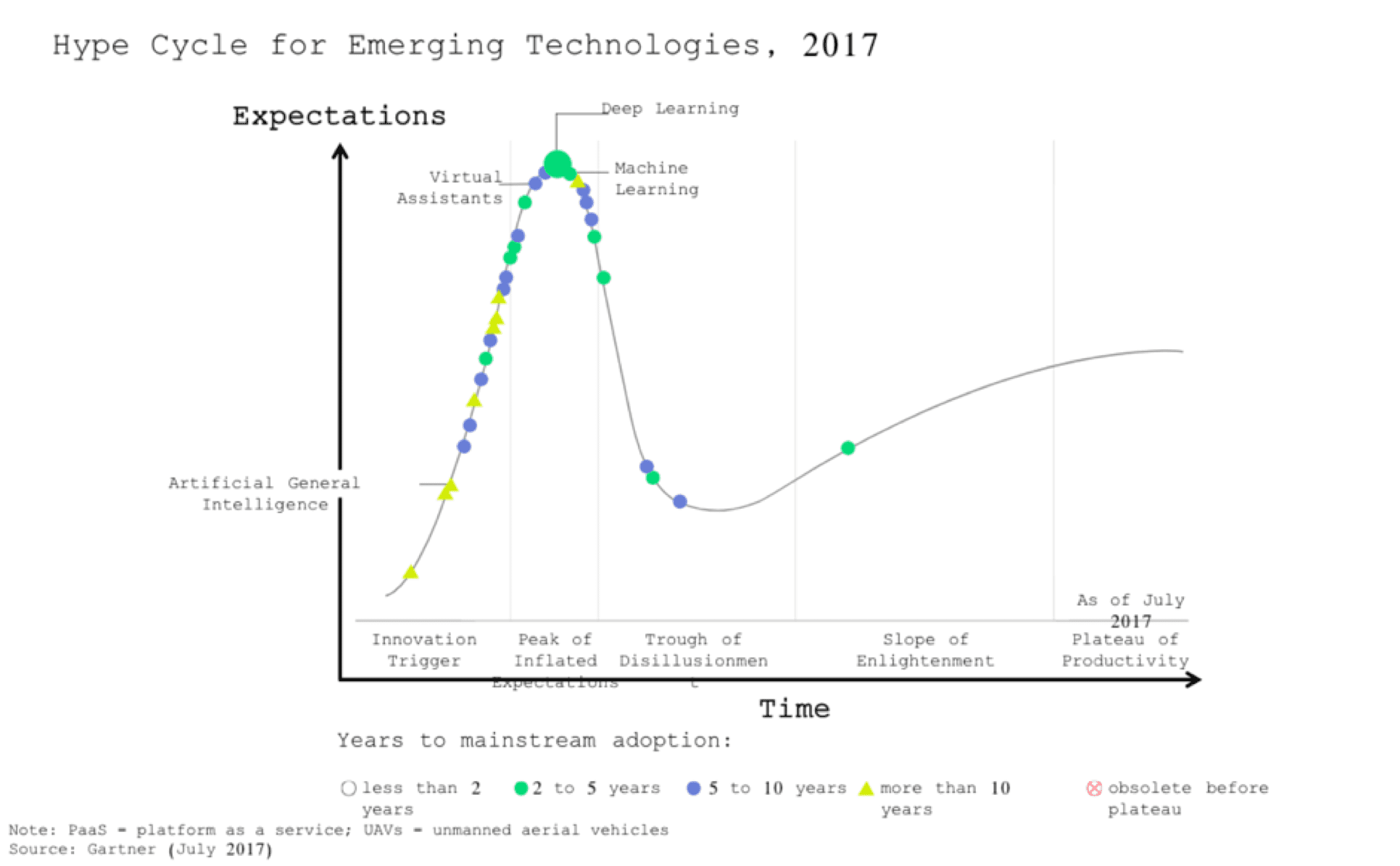
But AI is real, and it allows us to solve real problems for real people — to help our customers, by:
- Trying to anticipate what else they might find helpful in tandem with a current or recent purchase, e.g. via product recommendations
- Allowing customers to stay up-to-date with content that populates in real-time based on when it’s opened, e.g. weather updates or local hotel availability
- Making it easy to take the next best action in a given circumstance, e.g. with timely push notifications from a mobile app
As an optimization technology, and depending upon how much quality data you have and which technology you’re using, AI can help you deliver a mildly better to drastically enhanced customer experience.
Whether the marketing masses know it right now or not, AI has the potential to be the salvation that time-strapped, over-worked teams have been waiting for. AI systems will alleviate the repetitive tasks taking your time, and simultaneously even the playing field among pure-play e-tailers and retail brands. Algorithms are available to everybody.
AI marketing solutions connect the entire marketing spectrum, including customer data, access to that data by the marketer and machine, campaigns and content, and execution. AI will help revolutionize your role as a marketer and help you capitalize on the promise of marketing (currently going unfulfilled): true, 1-to-1 personalization for each and every one of your deserving customers.
Thanks to Raj Balasundaram for sharing his thoughts and opinions in this post. Raj Balasundaram is Vice President of Solutions and Strategic Services at Emarsys, where he helps leading brands leverage their digital platforms and data to out-maneuver competitors and achieve superior financial results. Raj has delivered presentations and talks at a variety of global conferences and road shows including #DMWF Expo Global, evangelizing the art of data intelligence-based marketing. Prior to Emarsys, Raj worked at both Oracle and ExactTarget. You can follow him on
Twitter, or connect with him on
LinkedIn.




